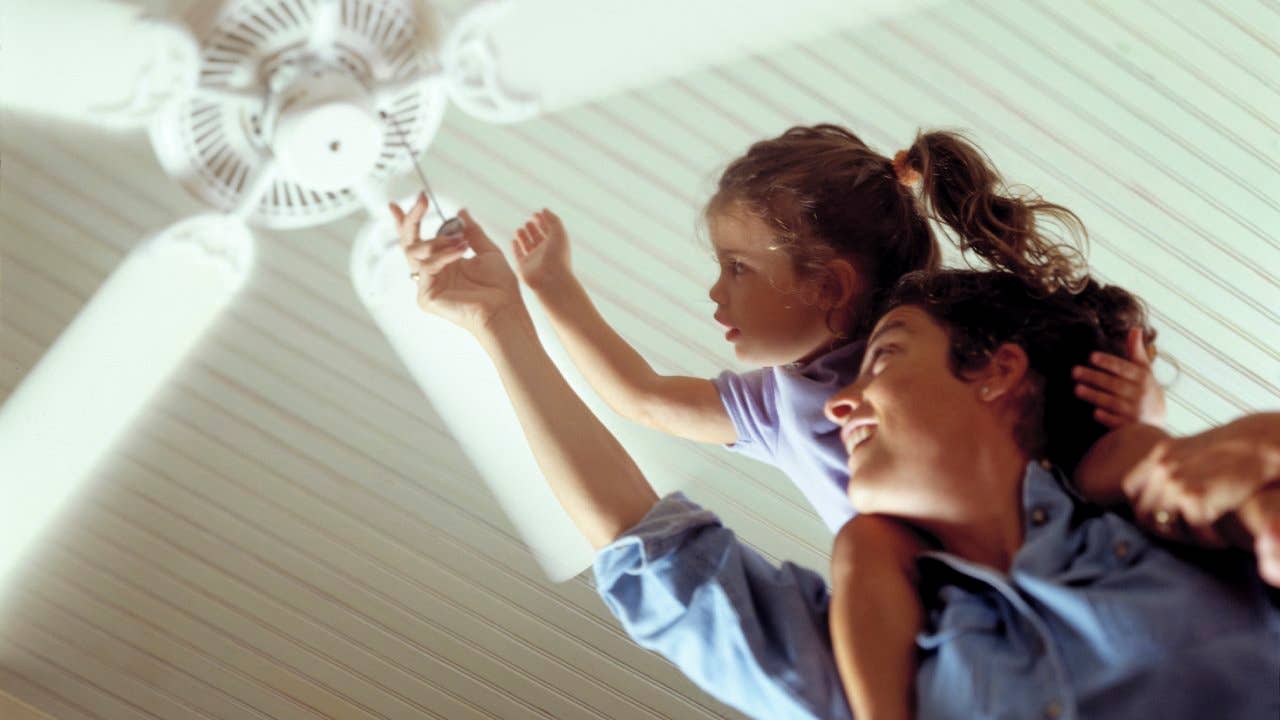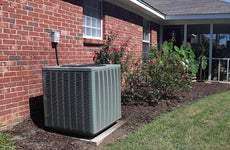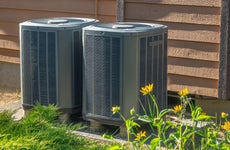What does it cost to install a ceiling fan?

The Bankrate promise
At Bankrate we strive to help you make smarter financial decisions. While we adhere to strict , this post may contain references to products from our partners. Here's an explanation for .
Key takeaways
- The average cost to install a ceiling fan runs from $250 to $700.
- The ceiling fan’s size, number of blades and the materials it’s made of influence the installation cost, as does the need for new or replacement wiring.
- Running a ceiling fan all day can cost you less than $1, and save on air conditioning and heating bills.
They may seem old-fashioned, but ceiling fans are actually a versatile bit of technology — a blast from the past that has a place in the most up-to-date home. Not only do they keep rooms cool and comfortable, but they can also save you money on your air conditioning bills.
At the height of summer, a ceiling fan will allow you to raise the thermostat setting about 4°F with no reduction in comfort, according to the U.S. Department of Energy. At night or during moderately hot weather, ceiling fans may allow you to avoid using your air conditioner altogether, thanks to their efficient movement of air. That can prolong its life and keep your energy costs manageable — financial wizardry at its finest.
How much do ceiling fans cost to install? Indoor ceiling fans on average range between $250 to $700 (including both the fan and the labor), with the average cost around $377. Outdoor fans range from $300 to $900. Our guide highlights the different kinds of ceiling fans available, factors influencing price, and how to determine how much fan you need for a particular room.
Ceiling fan cost by type
Ceiling fans are like the shoes of home improvement. They come in a variety of architectural styles, from farmhouse-rustic to industrial modern to tropical to Victorian, and with lights to match. There are even “fandeliers” — fans that incorporate chandeliers.
Style aside, most fans fall into certain type categories.
Standard
Standard ceiling fans average $50 to $300 per unit. With blades rotating parallel to the ceiling, these are the most common types found in houses and apartments. Some will also include a light fixture and dimmers to get that ambiance going. Standard ceiling fans come in every style and finish, making them enticing for all design tastes.
Low-profile
Similar to standard fans, low-profile derive their name from their close location to the ceiling; they lack any sort of downrod (see below), which makes them an ideal fit for rooms eight feet high or less. Costs for these models also run from $50 to $300.
Hanging propeller
The main characteristic of hanging propeller fans is they reach lower than other models: The fan’s propeller and blades hang from downrod, or pole. It makes them a suitable option for rooms with higher ceilings (aim for nine feet or more). Extremely good at pushing air, propeller fans can also be fantastic for retaining heat in the winter through reverse flow of their blades, making a room feel warmer. The costs for these fans are $100 to $500, though some go as high as $1,300.
Directional
Directional ceiling fans give you the ability to target specific areas with air. They achieve this by pointing in the direction of your choosing. You’ll have to budget more for these, as they run from $150 to $800.
Rotational ceiling fans
These models feature dual motors. It allows them to push more air, making them perfect for larger rooms. Rotational ceiling fans tend to be one of the more expensive types to buy, with prices typically ranging from around $620 to $1,1500 per model.
Factors that affect the cost of ceiling fans
Many factors feed into a ceiling-fan budget. One of the biggest influences is materials. Wood will run you between $100 to $400 per fan, while stainless steel fans range from $200 to $800, for example.
Another factor impacting prices is the number of blades your fan has. Two blades set you back $150-$500, while six blades can cost from $200 to $600. Of course, the more your fan has to work with, the better it will circulate air, and the more comfortable the room will feel.
You’ll also want to pay attention to the fan’s Underwriters Laboratories (UL) safety classification, especially if you are considering it for an outdoor area. The rating, indicated on a “UL Listed” label, reflects the degree of moisture-resistance the fan has. Dry-rated ceiling fans ($100-$1,100) are perfect for indoor areas where you won’t have to contend with the wet. For garages, porches, or any enclosed areas where there could be a presence of high humidity, you want damp-rated fans ($125 to $1,100). And for spaces open to the elements, like covered patios or decks, you’ll want to add wet-rated fans. These can resist the charms of rain. But they’re also expensive, with models ranging from $150 to $1,200.
And let’s not forget about the size of the downrod, the pipe connecting the fan’s motor to its blades. The longer the downrod, the more expensive the fan.
| Ceiling Height | Downrod length (inches) | Materials cost |
|---|---|---|
| Source: Homeguide | ||
| 9 feet | 6 | $5-$20 |
| 10 feet | 12 | $10-$40 |
| 11 feet | 18 | $20-$45 |
| 12 feet | 24 | $25-$50 |
| 13 feet | 36 | $30-$60 |
| 14 feet | 48 | $30-$75 |
| 15+ feet | 60 | $50-$100 |
Installation
Labor costs average $50 to $400 per indoor ceiling fan (up to $1,000 for outdoor). One key factor is whether you need to add or replace wiring to the ceiling: Doing this could increase the overall project expenditures by another $200 to $400, depending on its complexity. Unless you possess extensive experience in wiring, you’ll need to hire an electrician to do the job. And this could cost anywhere from $350 to $2,000.
You could go the DIY route if the electrical wiring is already in place in your ceiling — it’s not that different from installing any light fixture. Leonard Ang, CEO of iPropertyManagement adds, “In terms of wiring difficulty, ceiling fans usually aren’t too bad unless they have lots of extra features like multiple switches for different lights or something similar.”
Still, ceiling fans are heavy and unwieldy; so it might be best to have a handyman or a contractor to do it. “Hire a professional to hang your ceiling fan to ensure it’s secure, centered, and balanced. Unbalanced ceiling fans tend to wobble, hum, rattle, and fall down if you’re not careful,” Ang remarks.
What size ceiling fan do I need?

Of course, the size of the fan itself is going to affect its cost, too — the bigger it gets, the pricier it gets. Which leads to the question: What size fan do you need?
It mainly depends on the room size. You want the right proportion, both for looks (you don’t want the fan to overwhelm the space) and for efficiency (you want to feel a breeze, but don’t want to be blown to bits).
Fans work most efficiently when the blades are 7 to 9 feet above the floor and 10 to 12 inches below the ceiling, the Dept. of Energy advises. Ideally, the blades should be no closer than 8 inches to the ceiling and 18 inches from the walls.
For example, according to Fixr.com estimates, a room that’s 75 sq.ft. or less could accommodate at a maximum a 36-inch fan, which could cost up to $300, on average. A room that goes up to 144 sq.ft. could take up to a 44-inch fan (up to $500). For a room of 225 sq.ft., a fan approaching 54 inches would be suitable (max cost: $600). Fans that are 72 inches ($650) should be used in really large rooms or spaces — like 400 sq. ft.
What do ceiling fans cost to run?
Ceiling fans are cheap to run continuously. How cheap? “The cost to operate your ceiling fan will depend on its size and efficiency, but no matter what, it will be way cheaper than air conditioning,” says Beth Martin, a Charleston, South Carolina-based interior designer. “A typical fan will most often only cost a few pennies a day, even when it has been running all day. Compared to your air conditioning, that’s a no-brainer.”
And when it comes to time to make repairs to your efficient machine, they can run from $90 to $200.
Overall, ceiling fans offer exceptional efficiency and energy savings that can help pay for themselves and keep you comfortable. Talk about versatile beings.
Ceiling fan FAQ
-
Ceiling fans use on average around 75 watts. That works out to 0.05 to 0.20 kilowatts per hour. Financially, that means you pay less than $1 daily in electricity costs.
-
It costs between $0.10 to $0.70 per day, depending on the size of your ceiling fan, your electric utility rate, and your home’s energy efficiency. Even if you run your ceiling fan all day, it lasts 10 to 15 years while supplying cheaper comfort than your home’s air conditioning.
-
While not everyone is a fan of ceiling fans, generally, no, ceiling fans won’t decrease the value of your home. Increasingly, buyers care about energy-efficient home features, and ceiling fans definitely qualify, as they circulate the air, creating a more comfortable space at low cost. Even if a buyer doesn’t like your particular fan, they can swap it out for another — there are so many styles to choose from now, and replacing one is cheap, provided the wiring’s in good shape — or of course remove it entirely.
Related Articles



